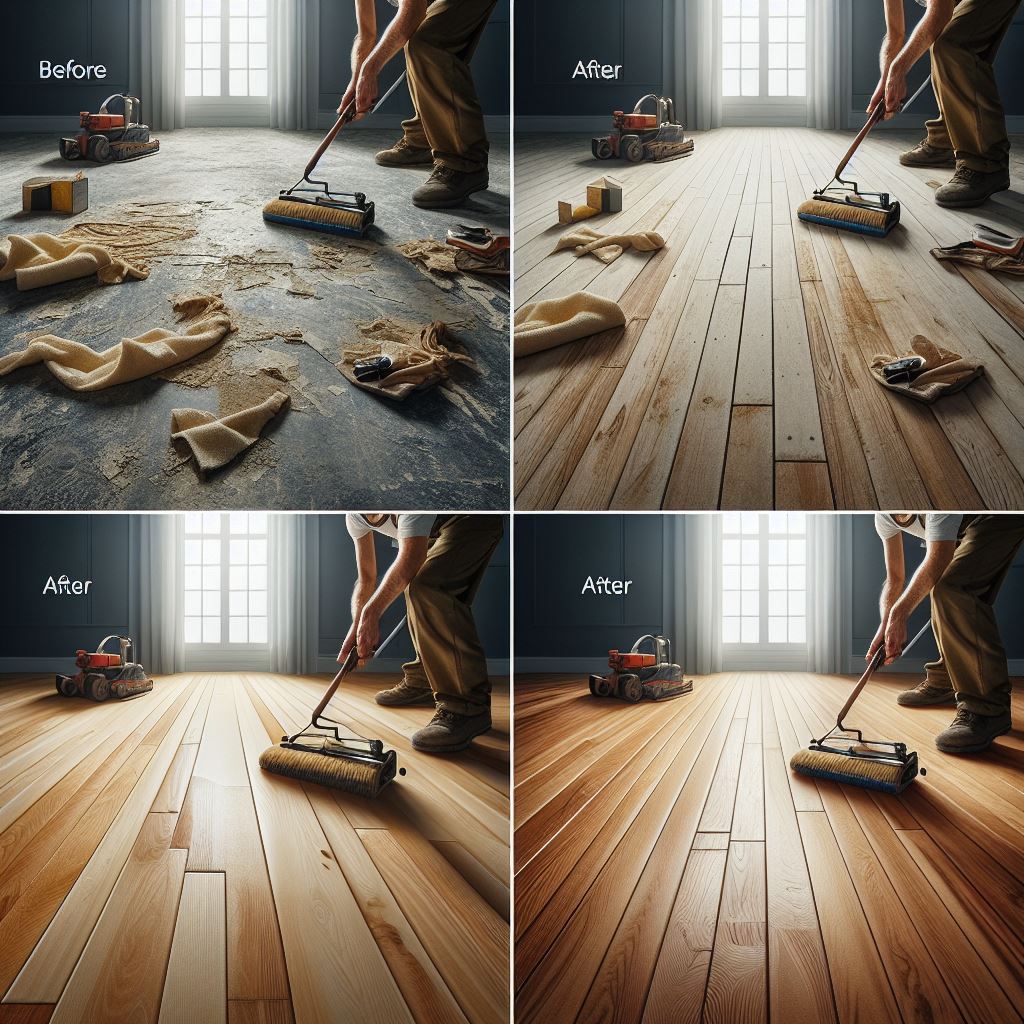Welcome to the world of engineered hardwood flooring. If you're considering a new flooring option for your home, you might have come across this term and wondered, what does engineered hardwood flooring mean? Unlike traditional solid hardwood, engineered hardwood is a versatile and innovative flooring solution that offers a blend of natural beauty and enhanced durability.
Engineered hardwood flooring consists of multiple layers, starting with a real hardwood veneer on the top, which gives it the authentic appearance of solid wood. Beneath this veneer are several layers of plywood or high-density fiberboard, stacked and bonded together in a cross-grain configuration. This unique construction makes engineered hardwood more stable and less susceptible to warping and swelling from moisture and temperature fluctuations.
Whether you're renovating your home or building a new one, engineered hardwood flooring can be an excellent choice. It combines the timeless elegance of hardwood with modern construction techniques to offer a robust and long-lasting flooring solution. Ready to transform your space with engineered hardwood flooring? Request a free estimate or email us at sales@paradise-spaces.com for more information!
Difference Between Engineered and Solid Hardwood

When choosing between engineered hardwood and solid hardwood, it's essential to understand the key differences to make an informed decision. While both options offer the natural beauty of wood, their construction and performance vary significantly.
Solid hardwood is made entirely from a single piece of wood, typically ¾ inch thick. This uniform construction means it can be sanded and refinished multiple times, which can extend its lifespan significantly. However, solid hardwood is more susceptible to changes in humidity and temperature, making it prone to expansion and contraction. This characteristic can limit its use in areas with high moisture, such as basements or bathrooms.
In contrast, engineered hardwood consists of a thin layer of real hardwood on top of several layers of plywood or high-density fiberboard. This multi-layer construction provides enhanced stability and resistance to moisture and temperature changes. As a result, engineered hardwood can be installed in a wider range of environments, including basements and over radiant heating systems.
While solid hardwood offers the advantage of multiple refinishing opportunities, engineered hardwood provides greater versatility and stability. Additionally, engineered hardwood often has a lower installation cost and can be installed using various methods, such as floating, gluing, or nailing. By understanding these differences, you can better determine which type of hardwood flooring best suits your needs and preferences.
Construction of Engineered Hardwood Flooring

The construction of engineered hardwood flooring is a masterful blend of natural beauty and advanced engineering. It is designed to offer the appearance of solid hardwood while providing enhanced stability and versatility. Understanding its construction can help you appreciate its benefits and make an informed choice for your home.
Engineered hardwood flooring typically consists of three main layers:
- Top Layer (Wear Layer): This is the topmost layer and is made of real hardwood. It showcases the natural grain, color, and texture that give your floor its aesthetic appeal. Depending on the quality, this layer can range in thickness from 0.5mm to 6mm, with thicker options allowing for light sanding and refinishing.
- Core Layer: The core layer is made of multiple layers of plywood, high-density fiberboard (HDF), or sometimes softwood. These layers are stacked in a cross-grain configuration, which significantly enhances the floor's dimensional stability. This construction minimizes the risk of warping, bowing, or cupping due to moisture and temperature fluctuations.
- Bottom Layer: The bottom layer, also known as the backing layer, is designed to provide additional stability and support. It is typically made of plywood or another type of wood and ensures a balanced structure, reducing the likelihood of the floor deforming over time.
This layered construction allows engineered hardwood to be more versatile in its installation methods. It can be installed over various subfloors, including concrete, and is suitable for areas where solid hardwood might struggle, such as basements and rooms with radiant heating systems.
By combining the elegance of real wood with advanced engineering, engineered hardwood flooring offers a durable, stable, and visually appealing option for modern homes.
Benefits of Engineered Hardwood Flooring
When considering flooring options, the benefits of engineered hardwood flooring stand out for their impressive combination of aesthetics, durability, and versatility. Here are some of the key advantages that make engineered hardwood an excellent choice for modern homes:
- Authentic Appearance: Engineered hardwood provides the same luxurious look and feel as solid hardwood, thanks to its real wood top layer. This means you don’t have to compromise on beauty when opting for engineered wood.
- Enhanced Stability: The layered construction of engineered hardwood makes it more stable than solid hardwood. The core layers, typically arranged in a cross-grain configuration, reduce the likelihood of warping, bowing, or cupping due to moisture and temperature changes.
- Versatile Installation: Engineered hardwood can be installed in various ways, including floating, gluing, or nailing down. It can be placed over different types of subfloors, such as concrete or existing flooring, making it suitable for a wide range of applications.
- Moisture Resistance: Thanks to its construction, engineered hardwood is more resistant to moisture compared to solid wood. This makes it an ideal choice for areas prone to humidity, such as basements and kitchens.
- Compatibility with Radiant Heating: Unlike solid hardwood, engineered wood can be safely installed over radiant heating systems, providing warmth and comfort without compromising the floor’s integrity.
- Eco-Friendly: Engineered hardwood uses less solid wood compared to traditional hardwood flooring, making it a more sustainable option. The core layers often utilize fast-growing woods or recycled materials, reducing the overall environmental impact.
- Cost-Effective: While still offering the beauty of real wood, engineered hardwood can be more affordable than solid hardwood. Its durability also means lower maintenance costs over time.
With these benefits, engineered hardwood flooring offers a practical and attractive solution for homeowners looking to enhance their living spaces with the timeless elegance of wood.
Maintenance Tips for Engineered Hardwood

To keep your engineered hardwood flooring looking its best and extend its lifespan, it's important to follow some essential maintenance tips. Here are practical steps to ensure your floor remains in pristine condition:
- Regular Cleaning: Sweep or vacuum your engineered hardwood floor regularly to remove dust and debris. Use a soft-bristle broom or a vacuum with a hardwood floor attachment to prevent scratches.
- Use the Right Products: Clean your floors with a damp (not wet) microfiber mop and a cleaner specifically designed for engineered hardwood. Avoid using excessive water or harsh chemicals, as these can damage the finish and underlying layers.
- Protect from Moisture: Wipe up spills immediately to prevent moisture from seeping into the wood. Use mats or rugs in high-moisture areas like kitchens and bathrooms to provide an extra layer of protection.
- Prevent Scratches: Place felt pads under furniture legs to avoid scratches and dents. Consider using area rugs in high-traffic zones to minimize wear and tear. Trim your pets' nails regularly to prevent them from scratching the floor.
- Control Indoor Climate: Maintain a consistent indoor humidity level between 30-50% to prevent the wood from expanding or contracting. Use a humidifier or dehumidifier as needed to keep the environment stable.
- Refinishing: Although engineered hardwood can be refinished, it usually has a thinner top layer than solid wood. Depending on the thickness of the veneer, it may be refinished once or twice during its lifespan. Consult a professional to determine if and when refinishing is necessary.
- Avoid Direct Sunlight: Prolonged exposure to direct sunlight can cause the wood to fade. Use curtains or blinds to protect the floor from UV rays, especially in rooms with large windows.
By following these maintenance tips, you can ensure that your engineered hardwood flooring remains beautiful and durable for many years to come.
Choosing the Right Engineered Hardwood Flooring

When it comes to choosing the right engineered hardwood flooring for your home, there are several factors to consider to ensure you make the best decision. Here’s what you need to keep in mind:
- Wood Species: Engineered hardwood is available in a variety of wood species, each offering distinct grain patterns and colors. Common choices include oak, maple, and hickory. Consider the aesthetic you want to achieve and choose a species that complements your interior design.
- Finish: The finish of the flooring can significantly impact its appearance and maintenance. Options range from high-gloss to matte finishes. A matte finish can help hide scratches and dents, while a high-gloss finish offers a more polished look.
- Plank Width: Wider planks can make a room feel more spacious, while narrower planks offer a more traditional look. The choice between wide and narrow planks often comes down to personal preference and the style of your home.
- Core Construction: The core layers of engineered hardwood can be made from plywood, high-density fiberboard (HDF), or softwood. Plywood cores are known for their stability and durability, making them a popular choice for high-traffic areas.
- Installation Method: Engineered hardwood can be installed using various methods, including floating, glue-down, or nail-down. Consider the installation process and whether you plan to do it yourself or hire a professional.
- Environmental Impact: If sustainability is a priority, look for engineered hardwood that is certified by the Forest Stewardship Council (FSC) or other recognized environmental organizations. These certifications ensure the wood is sourced responsibly.
Making an informed decision about your engineered hardwood flooring can elevate the look and feel of your home while providing long-lasting durability. For expert advice and personalized assistance, request a free estimate or email us at sales@paradise-spaces.com today!

One thought on “What Does Engineered Hardwood Flooring Mean? Find Out Here!”